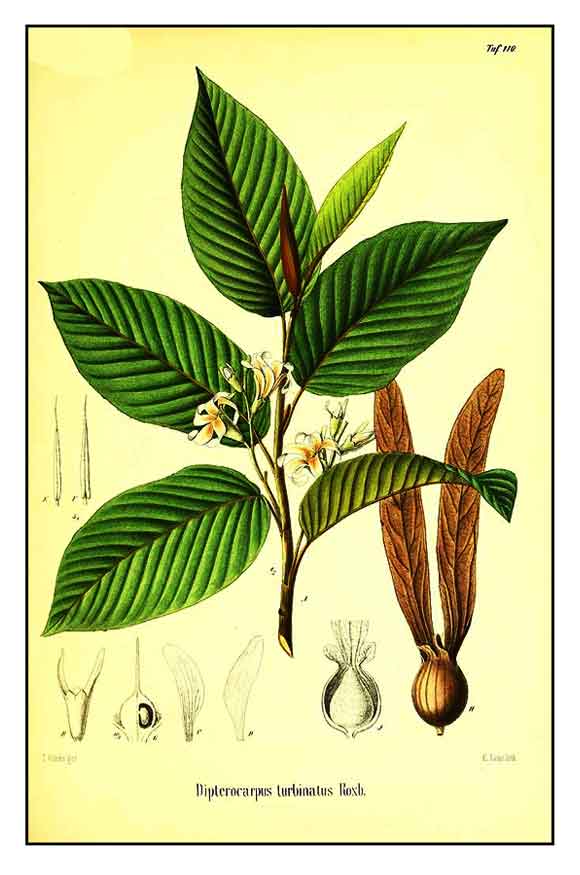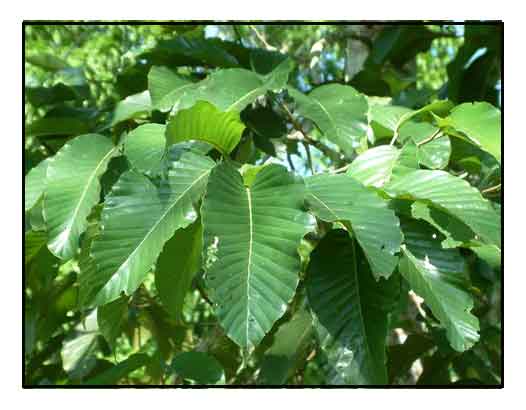
Family • Dipterocarpaceae
Mayapis
Dipterocarpus turbinatus C.F. Gaertn**.
GURJUN OIL TREE
Jie bu luo xiang
| Scientific names | Common names |
| Dipterocarpus jourdainii Pierre ex Laness. | Mayapis (Tag.) |
| Dipterocarpus jourdainii Pierre | Garjan oil tree (Engl.) |
| Dipterocarpus laevis Buch.-Ham. | Gurjun oil tree (Engl.) |
| Dipterocarpus mayapis Blanco | |
| Dipterocarpus turbinatus C.F.Gaertn | |
| Dipterocarpus turbinatus C.F.Gaertn is an accepted name. The Plant List | |
| Other vernacular names |
| ASSA,ESE: Garjan. Kherjong, Kural sal, Kurlikhal, Kuroil sal. |
| BENGALI: Kali garjan, Teli garjna, |
| CHINESE: Jie bu luo xiang. |
| INDIA: Gurjan, Gurjun, Gurgina. |
| KHMER: Chhë tië:l da:ng. |
| MALAY: Keruing. |
SANSKRIT: Ajakarna, Asvakarna. |
October 2020
![]()
 |
| PHOTOS / ILLUSTRATIONS |
| IMAGE SOURCE: / Illustration / Dipterocarpus turbinatus / click on image to go to source page / PlantIllustrations.org |
| OTHER IMAGE SOURCE: / Photograph / Dipterocarpus turbinatus / 1805 / click on image to go to source page / © FPCN.net |
| Additional
Sources and Suggested Readings (1) Dipterocarpus turbinatus / Synonyms / The Plant List (2) Diterocarpus turbinatus Gaertn / India Biodiversity Portal Sorting Passiflora names / /Maintained by: Michel H. Porcher / MULTILINGUAL MULTISCRIPT PLANT NAME DATABASE / Copyright © 1995 - 2020 / A Work in Progress. School of Agriculture and Food Systems. Faculty of Land & Food Resources. The Univers ity of Melbourne. Australia. (3) Dipterocarpus turbinatus / Indian Medicinal Plant / Ed: C P Khare / Springer, New York / DOI: https://doi.org/10.1007/978-0-387-70638-2_519 (4) Investigation of borneols sold in Taiwan by chiral gas chromatography (5) Anti-inflammatory and healing action of oral gel containing borneol monoterpene in chemotherapy-induced mucositis in rats (Rattus norvegicus) / Braz Jose do Nascimento-Junior, Lucas de Souza Brito, Elba Lucia Cavalcanti de Amorim et alv Brazilian Journal of Pharmaceutical Sciences, 2017; 53(3): e00081 / http://dx.doi.org/10.1590/s2175-97902017000300081 (6) A new source of natural D-borneol and its characteristic / Lei Chen, Jianyu Su, Lin Li, Bing Li1 and Wang Li2 / Journal of Medicinal Plants Research, Aug 2011; 5(15): pp 3440-3447 / ISSN: 1996-0875 (7) Cytotoxic activity screening of Bangladeshi medicinal plant extracts / Raushanara Akter, Shaikh J Uddin, Evelin Tiralongo et al / Journal of Natural Medicines, 2014; 68: pp 246-252 (8) Pharmacognostic study and establishment of quality parameter for medicinal plant of Dipterocarpaceae in Northeastern state Tripura / Diptanu Biswas, Gouda T Shivraj, N L Gowrishankar / International Journal of Green Pharmacy, Oct-Dec 2015; 9(4) Suppl (9) Insigni cant effect of ethanol extract of Dipterocarpus turbinatus (Dipterocarpaceae) bark on selected parameter in alloxan-induced diabetic rats / Diptanu Biswas, Shivraj T Gouda, Narayanaswamy Lachmanan Gowrishankar / Journal of Pharmaceutical Negative Results, Feb 2016 / DOI: 10.4103/0976-9234.177059 (10) Antimicrobial Activity of Ethanol Extracts and Isolated Fractions Shorea robusta Gaertn f and Dipterocarpus turbinatus Gaertn f / Diptano Biswas, Bandari Malalakshmi, B Samelu, M Devadas, Solleti Venkata Suresehkumar / Pharmacogn. Comm., 2020; 10(2): pp 102-107 (11) Hepatoprotective and Antioxidant Activity of Ethanol Extracts of Dipterocarpus turbinatus (Dipterocarpaceae) from Tripura / Diptanu Biswas, T Shivraj Gouda and Narayanswamy Lachmanan Gowrishankar / Journal of Natural Remedies / DOI: 10.18311/jnr/2016/7525 (12) A Survey of Medicinal Plants Used by Garo and Non-Garo Traditional Medicinal Practitioners in Two Villages of Tangail District, Bangladesh / Mohammed Rahmatullah Md et al / American Eurasian Journal of Sustainable Agriculture, 2011; 5(3): pp 350-357
|
DOI |
• |
| List of Understudied Philippine Medicinal Plants |
 |

 Botany
Botany
